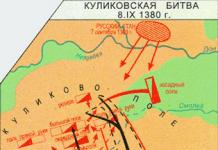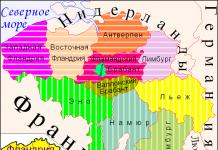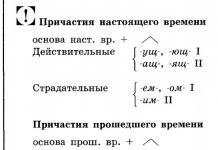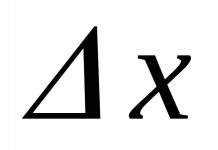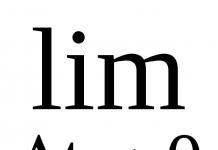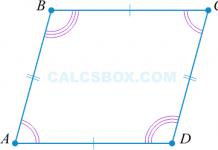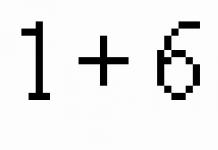An irrational number can be represented as an infinite non-periodic fraction. The set of irrational numbers is denoted by $I$ and it is equal to: $I=R / Q$ .
For example. Irrational numbers are:
Operations on irrational numbers
On the set of irrational numbers, four basic arithmetic operations can be introduced: addition, subtraction, multiplication, and division; but for none of the listed operations the set of irrational numbers has the property of closure. For example, the sum of two irrational numbers can be a rational number.
For example. Find the sum of two irrational numbers $0.1010010001 \ldots$ and $0.0101101110 \ldots$ . The first of these numbers is formed by a sequence of ones, separated respectively by one zero, two zeros, three zeros, etc., the second - by a sequence of zeros, between which one one, two ones, three ones, etc. are placed:
$$0.1010010001 \ldots+0.0101101110 \ldots=0.111111=0,(1)=\frac(1)(9)$$
Thus, the sum of two given irrational numbers is the number $\frac(1)(9)$ , which is rational.
Example
Exercise. Prove that the number $\sqrt(3)$ is irrational.
Proof. We will use the method of proof by contradiction. Suppose that $\sqrt(3)$ is a rational number, that is, it can be represented as a fraction $\sqrt(3)=\frac(m)(n)$ , where $m$ and $n$ are coprime natural numbers numbers.
We square both sides of the equality, we get
$$3=\frac(m^(2))(n^(2)) \Leftrightarrow 3 \cdot n^(2)=m^(2)$$
The number 3$\cdot n^(2)$ is divisible by 3. Therefore $m^(2)$ and hence $m$ is divisible by 3. Putting $m=3 \cdot k$, the equality $3 \cdot n^ (2)=m^(2)$ can be written as
$$3 \cdot n^(2)=(3 \cdot k)^(2) \Leftrightarrow 3 \cdot n^(2)=9 \cdot k^(2) \Leftrightarrow n^(2)=3 \cdot k^(2)$$
It follows from the last equality that $n^(2)$ and $n$ are divisible by 3, so the fraction $\frac(m)(n)$ can be reduced by 3. But by assumption, the fraction $\frac(m)( n)$ is irreducible. The resulting contradiction proves that the number $\sqrt(3)$ cannot be represented as a fraction $\frac(m)(n)$ and, therefore, is irrational.
Q.E.D.
We have already shown earlier that $1\frac25$ is close to $\sqrt2$. If it were exactly equal to $\sqrt2$, . Then the ratio - $\frac(1\frac25)(1)$, which can be turned into a ratio of integers $\frac75$ by multiplying the upper and lower parts of the fraction by 5, would be the desired value.
But, unfortunately, $1\frac25$ is not the exact value of $\sqrt2$. A more precise answer $1\frac(41)(100)$ is given by the relation $\frac(141)(100)$. We achieve even greater accuracy when we equate $\sqrt2$ to $1\frac(207)(500)$. In this case, the ratio in integers will be equal to $\frac(707)(500)$. But $1\frac(207)(500)$ is not the exact value of the square root of 2 either. Greek mathematicians spent a lot of time and effort to calculate the exact value of $\sqrt2$, but they never succeeded. They failed to represent the ratio $\frac(\sqrt2)(1)$ as a ratio of integers.
Finally, the great Greek mathematician Euclid proved that no matter how the accuracy of calculations increases, it is impossible to get the exact value of $\sqrt2$. There is no such fraction which, when squared, will give a result of 2. It is said that Pythagoras was the first to come to this conclusion, but this inexplicable fact so impressed the scientist that he swore himself and took an oath from his students to keep this discovery a secret. However, this information may not be true.
But if the number $\frac(\sqrt2)(1)$ cannot be represented as a ratio of integers, then no number containing $\sqrt2$, for example $\frac(\sqrt2)(2)$ or $\frac (4)(\sqrt2)$ also cannot be represented as a ratio of integers, since all such fractions can be converted to $\frac(\sqrt2)(1)$ multiplied by some number. So $\frac(\sqrt2)(2)=\frac(\sqrt2)(1) \times \frac12$. Or $\frac(\sqrt2)(1) \times 2=2\frac(\sqrt2)(1)$, which can be converted by multiplying the top and bottom by $\sqrt2$ to get $\frac(4) (\sqrt2)$. (We should not forget that no matter what the number $\sqrt2$ is, if we multiply it by $\sqrt2$ we get 2.)
Since the number $\sqrt2$ cannot be represented as a ratio of integers, it is called irrational number. On the other hand, all numbers that can be represented as a ratio of integers are called rational.
All integer and fractional numbers, both positive and negative, are rational.
As it turns out, most square roots are irrational numbers. Rational square roots only the numbers in the series have square numbers. These numbers are also called perfect squares. Rational numbers are also fractions made up of these perfect squares. For example, $\sqrt(1\frac79)$ is a rational number because $\sqrt(1\frac79)=\frac(\sqrt16)(\sqrt9)=\frac43$ or $1\frac13$ (4 is the root square of 16, and 3 is the square root of 9).
With a segment of unit length, ancient mathematicians already knew: they knew, for example, the incommensurability of the diagonal and the side of the square, which is equivalent to the irrationality of the number.
Irrational are:
Irrationality Proof Examples
Root of 2
Assume the contrary: it is rational, that is, it is represented as an irreducible fraction, where and are integers. Let's square the supposed equality:
.From this it follows that even, therefore, even and . Let where the whole. Then
Therefore, even, therefore, even and . We have obtained that and are even, which contradicts the irreducibility of the fraction . So the original assumption was wrong, and - irrational number.
Binary logarithm of the number 3
Assume the contrary: it is rational, that is, it is represented as a fraction, where and are integers. Since , and can be taken positive. Then
But it's clear, it's odd. We get a contradiction.
e
Story
The concept of irrational numbers was implicitly adopted by Indian mathematicians in the 7th century BC, when Manawa (c. 750 BC - c. 690 BC) found that the square roots of some natural numbers, such as 2 and 61 cannot be explicitly expressed.
The first proof of the existence of irrational numbers is usually attributed to Hippasus of Metapontus (c. 500 BC), a Pythagorean who found this proof by studying the lengths of the sides of a pentagram. In the time of the Pythagoreans, it was believed that there is a single unit of length, sufficiently small and indivisible, which is an integer number of times included in any segment. However, Hippasus argued that there is no single unit of length, since the assumption of its existence leads to a contradiction. He showed that if the hypotenuse of an isosceles right triangle contains an integer number of unit segments, then this number must be both even and odd at the same time. The proof looked like this:
- The ratio of the length of the hypotenuse to the length of the leg of an isosceles right triangle can be expressed as a:b, where a and b selected as the smallest possible.
- According to the Pythagorean theorem: a² = 2 b².
- Because a² even, a must be even (since the square of an odd number would be odd).
- Because the a:b irreducible b must be odd.
- Because a even, denote a = 2y.
- Then a² = 4 y² = 2 b².
- b² = 2 y², therefore b is even, then b even.
- However, it has been proven that b odd. Contradiction.
Greek mathematicians called this ratio of incommensurable quantities alogos(inexpressible), but according to the legends, Hippasus was not paid due respect. There is a legend that Hippasus made the discovery while on a sea voyage and was thrown overboard by other Pythagoreans "for creating an element of the universe, which denies the doctrine that all entities in the universe can be reduced to whole numbers and their ratios." The discovery of Hippas put before Pythagorean mathematics serious problem, destroying the assumption underlying the whole theory that numbers and geometric objects are one and inseparable.
see also
Notes
| Numerical systems | |
|---|---|
| Counting sets |
Integers () |
Definition of an irrational number
Irrational numbers are those numbers that, in decimal notation, are infinite non-periodic decimal fractions.

So, for example, numbers obtained by taking the square root of natural numbers are irrational and are not squares of natural numbers. But not all irrational numbers are obtained by extracting square roots, because the number "pi" obtained by dividing is also irrational, and you are unlikely to get it when trying to extract the square root from a natural number.
Properties of irrational numbers
Unlike numbers written in infinite decimal fractions, only irrational numbers are written in non-periodic infinite decimal fractions.
The sum of two non-negative irrational numbers can eventually be a rational number.
Irrational numbers define Dedekind sections in the set of rational numbers, in the lower class which do not have a large number, and there is no smaller one in the upper one.
Any real transcendental number is irrational.
All irrational numbers are either algebraic or transcendental.
The set of irrational numbers on the line are densely packed, and between any two of its numbers there is bound to be an irrational number.
The set of irrational numbers is infinite, uncountable and is a set of the 2nd category.
When performing any arithmetic operation on rational numbers, except division by 0, its result will be a rational number.
When adding a rational number to an irrational number, the result is always an irrational number.
When adding irrational numbers, we can get a rational number as a result.
The set of irrational numbers is not even.
Numbers are not irrational
Sometimes it is quite difficult to answer the question of whether a number is irrational, especially in cases where the number is in the form of a decimal fraction or in the form of a numerical expression, root or logarithm.
Therefore, it will not be superfluous to know which numbers are not irrational. If we follow the definition of irrational numbers, then we already know that rational numbers cannot be irrational.
Irrational numbers are not:
First, all natural numbers;
Second, integers;
Thirdly, ordinary fractions;
Fourth, different mixed numbers;
Fifth, these are infinite periodic decimal fractions.
In addition to all of the above, any combination of rational numbers that is performed by the signs of arithmetic operations, such as +, -, , :, cannot be an irrational number, since in this case the result of two rational numbers will also be a rational number.
Now let's see which of the numbers are irrational:

Do you know about the existence of a fan club where fans of this mysterious mathematical phenomenon are looking for more and more information about Pi, trying to unravel its mystery. Any person who knows by heart a certain number of Pi numbers after the decimal point can become a member of this club;
Did you know that in Germany, under the protection of UNESCO, there is the Castadel Monte palace, thanks to the proportions of which you can calculate Pi. A whole palace was dedicated to this number by King Frederick II.
It turns out that the number Pi was tried to be used in construction Tower of Babel. But to our great regret, this led to the collapse of the project, since at that time the exact calculation of the value of Pi was not sufficiently studied.
Singer Kate Bush in her new disc recorded a song called "Pi", in which one hundred and twenty-four numbers from the famous number series 3, 141 sounded ... ..
and π
Thus, the set of irrational numbers is the difference I = R ∖ Q (\displaystyle \mathbb (I) =\mathbb (R) \backslash \mathbb (Q) ) sets of real and rational numbers.
The existence of irrational numbers, more precisely segments that are incommensurable with a segment of unit length, was already known to ancient mathematicians: they knew, for example, the incommensurability of the diagonal and the side of the square, which is equivalent to the irrationality of the number 2 (\displaystyle (\sqrt (2))).
Properties
- The sum of two positive irrational numbers can be a rational number.
- Irrational numbers define Dedekind sections in the set of rational numbers that have no largest number in the lower class and no smallest number in the upper one.
- The set of irrational numbers is everywhere dense on the real line: between any two different numbers there is an irrational number.
- The order on the set of irrational numbers is isomorphic to the order on the set of real transcendental numbers. [ ]
Algebraic and transcendental numbers
Every irrational number is either algebraic or transcendental. Lots of algebraic numbers is a countable set. Since the set of real numbers is uncountable, the set of irrational numbers is uncountable.
The set of irrational numbers is a set of the second category.
Let's square the supposed equality:
2 = m n ⇒ 2 = m 2 n 2 ⇒ m 2 = 2 n 2 (\displaystyle (\sqrt (2))=(\frac (m)(n))\Rightarrow 2=(\frac (m^(2 ))(n^(2)))\Rightarrow m^(2)=2n^(2)).Story
Antiquity
The concept of irrational numbers was implicitly adopted by Indian mathematicians in the 7th century BC, when Manawa (ca. 750-690 BC) found that the square roots of some natural numbers, such as 2 and 61, could not be expressed explicitly [ ] .
The first proof of the existence of irrational numbers, or rather the existence of incommensurable segments, is usually attributed to the Pythagorean Hippasus of Metapontus (ca. 470 BC). At the time of the Pythagoreans, it was believed that there is a single unit of length, sufficiently small and indivisible, which is an integer number of times included in any segment [ ] .
There is no exact data on the irrationality of which number was proved by Hippasus. According to legend, he found it while studying the lengths of the sides of the pentagram. Therefore, it is reasonable to assume that this was the golden ratio, since this is the ratio of the diagonal to the side in a regular pentagon.
Greek mathematicians called this ratio of incommensurable quantities alogos(inexpressible), but according to the legends, Hippasus was not paid due respect. There is a legend that Hippasus made the discovery while on a sea voyage and was thrown overboard by other Pythagoreans "for creating an element of the universe, which denies the doctrine that all entities in the universe can be reduced to whole numbers and their ratios." The discovery of Hippasus posed a serious problem for Pythagorean mathematics, destroying the assumption underlying the whole theory that numbers and geometric objects are one and inseparable.
Later, Eudoxus of Cnidus (410 or 408 BC - 355 or 347 BC) developed a theory of proportions that took into account both rational and irrational relationships. This served as the basis for understanding the fundamental essence of irrational numbers. The value began to be considered not as a number, but as a designation of entities, such as line segments, angles, areas, volumes, time intervals - entities that can change continuously (in the modern sense of the word). Values were opposed to numbers, which can only change by “jumping” from one number to the next, for example, from 4 to 5. Numbers are made up of the smallest indivisible value, while quantities can be reduced indefinitely.
Since no quantitative value was compared to a magnitude, Eudoxus was able to cover both commensurable and incommensurable magnitudes by defining a fraction as the ratio of two quantities, and proportion as the equality of two fractions. By removing quantitative values (numbers) from equations, he avoided the trap of having to call an irrational quantity a number. The theory of Eudoxus allowed Greek mathematicians to make incredible progress in geometry, providing them with the necessary rationale for working with incommensurable quantities. The tenth book of "Beginnings" by Euclid is devoted to the classification of irrational quantities.
Middle Ages
The Middle Ages were marked by the adoption of such concepts as zero, negative numbers, integers and fractional numbers, first by Indian, then by Chinese mathematicians. Later, Arab mathematicians joined in, who were the first to consider negative numbers as algebraic objects (along with equal rights with positive numbers), which allowed the development of the discipline now called algebra.
Arab mathematicians combined the ancient Greek concepts of "number" and "value" into a single, more general idea of real numbers. They were critical of Euclid's ideas about relations, in contrast to it, they developed the theory of relations of arbitrary quantities and expanded the concept of number to relations continuous quantities. In his commentaries on Book 10 of Euclid's Elements, the Persian mathematician Al Mahani (c. 800 AD) explored and classified quadratic irrational numbers (numbers of the form) and more general cubic irrational numbers. He gave a definition of rational and irrational quantities, which he called irrational numbers. He easily operated on these objects, but he reasoned as separate objects, for example:
In contrast to Euclid's concept that quantities are primarily line segments, Al Mahani considered integers and fractions to be rational quantities, and square and cube roots to be irrational. He also introduced an arithmetic approach to the set of irrational numbers, since it was he who showed the irrationality of the following quantities:
The Egyptian mathematician Abu Kamil (c. 850 CE - ca. 930 CE) was the first to find it acceptable to accept irrational numbers as a solution quadratic equations or coefficients in equations - mainly in the form of square or cube roots, as well as fourth roots. In the 10th century, the Iraqi mathematician Al Hashimy provided general proofs (rather than visual geometric demonstrations) of the irrationality of the product, the quotient, and the results of other mathematical transformations of irrational and rational numbers. Al Khazin (900 CE - 971 CE) gives the following definition of rational and irrational quantity:
| Let a single value be contained in a given value one or more times, then this [given] value corresponds to an integer ... Each value that is half, or a third, or a quarter of a single value, or, compared with a single value, is three fifths of it, this rational value. And in general, any quantity that is related to the unit as one number is to another, is rational. If the value cannot be represented as several or part (l / n), or several parts (m / n) of unit length, it is irrational, that is, inexpressible except with the help of roots. |
Many of these ideas were later adopted by European mathematicians after the translation of Arabic texts into Latin in the 12th century. Al Hassar, an Arab mathematician from the Maghreb who specialized in Islamic inheritance laws, introduced modern symbolic mathematical notation for fractions in the 12th century, separating the numerator and denominator with a horizontal bar. The same notation then appeared in the works of Fibonacci in the thirteenth century. During the XIV-XVI centuries. Madhava from Sangamagrama and representatives of the Kerala School of Astronomy and Mathematics investigated infinite series that converge to some irrational numbers, for example, to π, and also showed the irrationality of some trigonometric functions. Jestadeva reported these results in the book "Yuktibhaza". (while proving the existence of transcendental numbers), thereby rethinking Euclid's work on the classification of irrational numbers. On this topic, works were published in 1872
Continued fractions, closely related to irrational numbers (the continued fraction representing a given number is infinite if and only if the number is irrational), were first investigated by Cataldi in 1613, then again attracted attention in the work of Euler, and in early XIX century - in the works of Lagrange. Dirichlet also made a significant contribution to the development of the theory of continued fractions. In 1761, Lambert showed using continued fractions that π (\displaystyle \pi ) is not a rational number, and also that e x (\displaystyle e^(x)) and tg x (\displaystyle \operatorname (tg) x) are irrational for any nonzero rational x (\displaystyle x). Although Lambert's proof can be called incomplete, it is generally considered to be quite rigorous, especially given the time it was written. Legendre in 1794, after introducing the Bessel-Clifford function, showed that π 2 (\displaystyle \pi ^(2)) irrational, whence irrationality π (\displaystyle \pi ) follows trivially (a rational number squared would give a rational number).
The existence of transcendental numbers was proved by Liouville in 1844-1851. Later, Georg Cantor (1873) showed their existence using a different method and proved that any interval of the real series contains infinitely many transcendental numbers. Charles Hermite proved in 1873 that e transcendent, and Ferdinand Lindemann in 1882, based on this result, showed the transcendence π (\displaystyle \pi ) Literature






